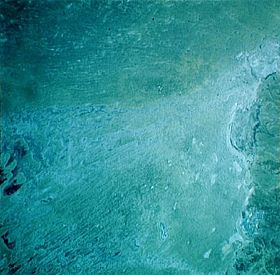Lake Callabonna facts for kids
Quick facts for kids Lake Callabonna |
|
|---|---|

Lake Callabonna from space
|
|
| Location | Far North, South Australia |
| Coordinates | 29°43′S 140°05′E / 29.717°S 140.083°E |
| Type | Salt lake |
| Basin countries | Australia |
| Designation | Strzelecki Regional Reserve (only partially) Lake Callabonna Fossil Reserve |
| Surface area | 160 km2 (62 sq mi) |
Lake Callabonna is a large, dry salt lake in the Far North of South Australia. It's mostly flat and doesn't have many plants growing there. This lake covers about 160 square kilometers (about 62 square miles). It is located about 120 kilometers (75 miles) southwest of Cameron Corner, where South Australia, Queensland, and New South Wales meet. Sometimes, people also call it Lake Mulligan.
Lake Callabonna is very important because of the ancient fossils found there. These fossils are from the late Pleistocene period, which was a long time ago. The lake is also part of the Strzelecki Desert Lakes Important Bird Area. This area is special because many waterbirds gather here when the lake fills with water after big floods.
Contents
Discovering Ancient Life at Lake Callabonna
Early Explorers and Fossil Finds
The first people to raise sheep in this area were the Ragless brothers in 1881. They moved their sheep from the northern Flinders Ranges to set up a sheep farm. In 1892, the owner of the farm, F. B. Ragless, was shown something amazing. An Aboriginal station worker named Jackie Nolan had found several huge skeletons stuck in the dry surface of the lake just two days before.
Museum Expeditions and Important Discoveries
The South Australian Museum quickly sent a worker named H. Hurst to check out the site. Four months later, his findings were sent back to the museum. After looking at the skeletons, a big trip was planned. This trip was paid for by Sir Thomas Elder and led by E. C. Stirling, who was the director of the South Australian Museum. Hurst guided the team back to the lake.
After several visits, Stirling and A. H. C. Zietz collected many skeletons of giant animals. These included diprotodons, which were huge, ancient marsupials, and dromornithidae, which were giant flightless birds. Because of these important finds, the area was made a Fossil Reserve in 1901. Access to the site is now limited to protect these valuable fossils.
Protecting Lake Callabonna's Treasures
Strzelecki Regional Reserve Connection
Part of the northern end of Lake Callabonna is located within the Strzelecki Regional Reserve. This reserve helps protect the natural environment of the area.
Lake Callabonna Fossil Reserve Status
Lake Callabonna is famous for being the place where complete skeletons of the extinct Diprotodon were found. These giant marsupials lived long ago. The site is considered to be very important for understanding ancient life.
In 1901, a special Fossil Reserve was created under state law to protect the area. The South Australian Museum is in charge of looking after it. In 2002, it was noted that the lake didn't get much special care as a Fossil Reserve. It was suggested that making it a protected area under a different law might give it even more protection from damage. The site was officially added to the South Australian Heritage Register on February 13, 1997, recognizing its historical and scientific value.


